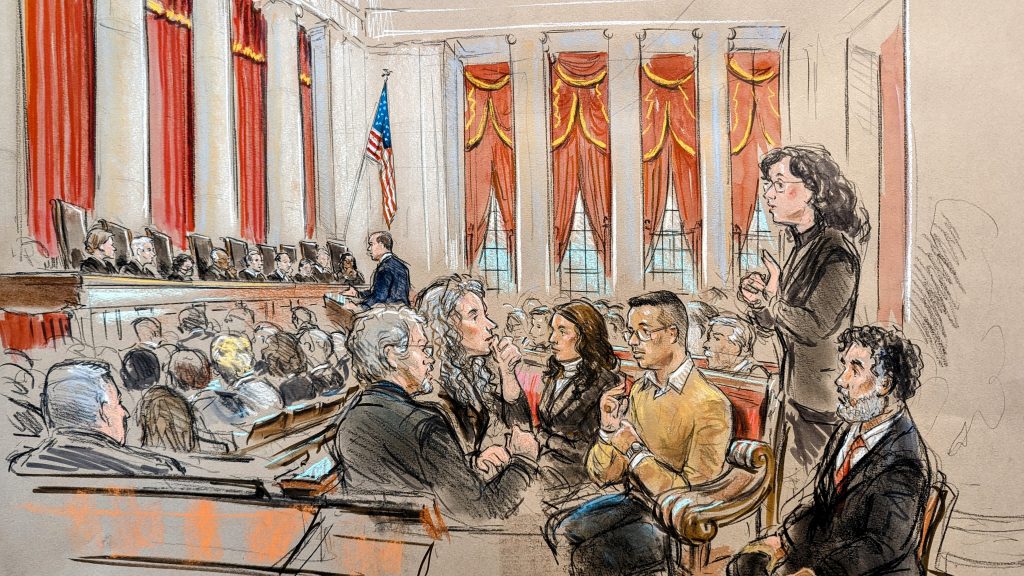Podcast: Play in new window | Download (Duration: 15:18 — 21.1MB)
Subscribe: RSS
This week, we continue our discussion of the Supreme Court case heard last Wednesday, Perez V Sturgis school district. The case concerns two laws: the Individuals with Disabilities Education Act or IDEA, which requires children with disabilities be provided a “free appropriate public education” or (FAPE) and the Americans with Disabilities Act (ADA), which prohibits discrimination against individuals with disabilities in general.
Miguel Luna Perez of Sturgis Michigan was denied access to a professional sign language interpreter and was instead provided with an effective one over the course of 12 years. I’m that time. parents were falsely told that their son was on his way to graduation, only to receive a certificate of completion instead of a diploma upon completing his senior year of high school.
After receiving the news, the Perez family filed a lawsuit against the Michigan Dept. of Education and the Sturgis school board, on the grounds that the school violated both the Idea and ADA acts.
However, the Sturgis school district offered a settlement to pay for Perez to attend the Michigan School for the deaf and compensate the family’s legal fees, which would satisfy Perez’s lawsuit under the IDEA should the family accept.
The family accepted the settlement but then filed a lawsuit for monetary damages under the ADA, which entitles victims of disability discrimination to do so separately.
The question now is whether by accepting the district’s settlement, the Perez family also forfeited their right to further litigation for monetary damages under the ADA.
Prior to the supreme court hearing last week, the sixth circuit court of appeals ruled that Perez had forfeited his right to sue under the ADA by settling instead of going through the lengthy process of appeals for both claims.
This process is known in legal speak as exhaustion and is mandated by the IDEA, a claim echoed by Sturgis district lawyer Shay Dvoretzky in Last week’s hearing.
On the other side, Perez’s lawyer Ramon Martinez argued that although Perez had settled his claims under the IDEA, he could still pursue his claim for monetary damages separately under the ADA.
Today, we go through some of the most notable moments of the hearing involving exchanges between the supreme court justices and both Ramon Martinez and Shay Dvoretzky. This is a new segment of Disabulletin’s coverage we call Jewels of Justice

Jewel#1 is one that we discussed last week that occurred at the beginning of the Justice question period for Perez’s attorney Ramon Martinez:
JUSTICE THOMAS: Well, I guess the
difference — the difficulty I’m having is I
can’t see where ADA fits in with IDEA.
MR. MARTINEZ: Right.
JUSTICE THOMAS: That seems to be an
entirely different remedy…
MR. MARTINEZ: A hundred percent, Your
Honor. I think that’s exactly the right way to
think about the statute. And I think what
Congress was trying to do here was essentially
say we want you to have rights under both
statutes, we want you to be able to go into
court if necessary and vindicate your separate
rights to separate types of relief under both
statutes. But, in circumstances — in certain
circumstances, we want you to go through the
IDEA administrative procedures first.
And the text of the statute says that
if your ADA claim is only seeking things that
you can’t get under the IDEA, in the words of
Fry, if the consequence of your ADA claim, if
you brought it in the IDEA procedure, would be
that the IDEA hearing officer would have to
send you away empty-handed because that statute
just does not provide you that type of relief,
that type of relief is not available, then you
do not have to exhaust.
JUSTICE THOMAS: I guess that’s why
I’m having trouble considering it exhaustion.
MR. MARTINEZ: Right.
CHIEF JUSTICE ROBERTS: — the — the two are not entirely unrelated. I mean, in
each — in both cases, your — your claims are
going to be based on the denial of an FAPE or a
FAPE. And it’s certainly reasonable to assume
that the settlement process under the IDEA
could well be significant in resolving the
other claims.
It seems to me that what’s unusual in
this case is that the school board said, well,
don’t worry about those, we’re going to settle
this. I mean, if this were any other type of
litigation, the lawyers would want to say,
we’ve got a lot on the table and let’s figure
out how to resolve it.
And it’s not clear to me why you would
necessarily or artificially separate those two.
And, of course, your — your friend on the
other side has a construction answer to your
notion of how the exhaustion works, that
relief, the relief you’re seeking, is based on
a FAPE. That’s what’s going to be pertinent in
all those cases. Why isn’t that —
MR. MARTINEZ: So — so two points to
that, Your Honor. First of all, I think it’s
certainly true that if you bring the IDEA
claim, you could have a settlement discussion
that encompasses not just the IDEA claims but
also other claims that you might have that
haven’t yet been asserted in that process.
And I think the normal thing that we
would expect is that when bargain — when
parties are bargaining and if this — if the
child is going to give up those other claims,
they’re going to get something in return.
In this case, that settlement
discussion happened, and, you know, the —
the — there was a settlement discussion, and
Miguel would have turned down a request to give
up ADA rights without any compensation for
those ADA rights.
And the effect of Sturgis’s rule is
that if he accepts the settlement on the IDEA
claim, it, like, automatically gets rid of —
it essentially gives the school a full release,
a get-out-of-jail-free card on the ADA
liability, and that’s just not right.
In the clip we just heard, it appeared as though Justice John Roberts and Thomas were expressing mutual confusion regarding why settlement claims were different under the ADA and IDEA acts when they could in fact be similar?
But now, we turn to our second gem, in which Justice Ketanji Brown Jackson appears to Join Justice Roberts and Thomas on the question of the strange idea that IDEA and ADA damages can go to court at the same time!
JUSTICE JACKSON: “And even — even if it is odd, though, Mr. Martinez, isn’t that exactly what the statute seems to contemplate? I mean, I guess I’m wondering whether or not we’re even in a position to question the notion of dual proceedings, given that at least as I read the statute, Congress is contemplating that you’ll have a situation in which there’s a civil action that’s seeking relief that is not available under the IDEA. So I — I take this to mean that Congress thought that dual actions at least in some circumstances were possible and that was fine.
MR. MARTINEZ: I think that’s exactly right under the statute. And I think that the nice thing about the statute is that it doesn’t take away the — the inherent discretion of district courts to manage their dockets in this way. And if you thought or five of you thought that it was important to give some guidance to lower courts and sort of remind them that if they wanted to — to stay parallel proceedings, if you were concerned about that, you could do that. On the other hand, Justice Jackson, I think you are right that the statute does not seem to say that it has to be a stay.
JUSTICE JACKSON: I mean, in — in — in my view — and maybe you can just react to that — isn’t — isn’t what really is going on here that Congress was concerned about people doing an end run around the IDEA in a certain way? That is, you have, you know, a set of facts concerning the denial of a FAPE that could give rise to claims under, let’s say, both of these statutes, the IDEA and the ADA, and, you know, the — the plaintiff is the master of their complaint and can decide which statute to bring it under. And so, in a situation in which the relief that is being asked for is only the kind of relief that is available under the IDEA, maybe Congress didn’t want the person to call that an ADA statute and thereby get around the exhaustion. But, if you’re asking for something else, if your claim is something else, then Congress didn’t have a problem with both of those proceeding in tandem.”
MR.MARTINEZ:I — I think that’s — that’s absolutely a fair way of looking at the statute, and there’s certainly no circumvention concern when the only thing you need is something that you can’t get under the IDEA.
We now turn to the man in the defendant corner on this case, Shay Dvoretzky representing Sturgis.
Our first moment in his exchange with the justices occurred late in the proceedings before Justice Neil Gorsuch, who questioned Dvoretzky on the extent to which Martinez had to fully exhaust his claims under both IDEA and ADA.
JUSTICE GORSUCH:On that, I — I — I just want to press you on that assertion because your friend on the other side says, no, if we were to adopt your rule, the parties couldn’t contract to allow an ADA claim to be brought later, that a settlement would itself extinguish the potential for an ADA claim. You have to exhaust — your theory of exhaustion requires proceeding through the administrative process altogether. Do you want to respond to that?
SHAY DVORETSKY:Yes. I don’t think that’s right, Justice Gorsuch. I think that the exhaustion requirement under the IDEA, in light of this Court’s clear statement rule, although it’s not a fourth question presented here, I don’t think the Court would likely find that the exhaustion requirement is a jurisdictional one. And so it is something that, either way, whether you adopt our rule or
JUSTICE GORSUCH:Well, absent waiver by the other side, it would operate in the way Mr. Martinez suggests, wouldn’t it?
SHAY DVORETSKY:Absent a waiver, it would, and that, I think, takes us to the default rule point.
And in our final highlight, we find a diamond in the rough that came from our Most Valuable Justice in this Case, Ketanji Brown Jackson.
JUSTICE JACKSON:Can I ask you the same — maybe the same question as the hypothetical just so that I understand because I think I’m a little confused? So suppose we have a student who has both a viable IDEA claim and a viable ADA claim arising out of the same facts, which is the school is not giving her what she needs to get an appropriate education. But, for whatever reason, she only wants to bring the claim for money damages. Maybe she’s going into her senior year, she’s given up on education and she wants to go to work, so she doesn’t want any of the, you know, adjust my education, give me the actual accommodations. She just wants to drop out and go to work and get compensatory damages for the harm that’s been caused, she says, by the school’s neglect under the ADA. Does she have to exhaust using the procedures in this statute or not?
SHAY DVORETSKY: I think she does, but, in order to answer that question, I also have to just challenge one premise of it, which is I think that in — generally speaking, even after you have graduated, you can still get redress for the denial of a FAPE through the IDEA in —
JUSTICE JACKSON: But not compensatory damages. She doesn’t want any of the injunctive relief related to the circumstances of education. So whatever the relief is that she could have gotten from the hearing officer about the state or status of her educational circumstances she disclaims. All she wants is to be compensated for what she says occurred to her during the period of her education. And so she says: I don’t want to bring an IDEA claim, I have an ADA claim. Does she have to sit in front of the hearing officer and talk about ways in which her education could be changed, et cetera?
SHAY DVORETSKY: Yes.
And I think what she could get under the IDEA in that situation is compensatory education. She can have additional, even after she’s graduated, additional forward —
JUSTICE JACKSON: But she doesn’t want that. She doesn’t want that. She doesn’t — she’s saying: I’m 18, I don’t have to go to school anymore, I don’t want to go to school anymore, I’m dropping out, I just want compensatory damages under the ADA. What I’m trying to understand is why do we have a statute in your view that would make her exhaust under the IDA — the IDEA, as if she was asking for that other form of relief?
SHAY DVORETSKY:Because whatever her preference is as to damages, Congress’s priority in enacting the ADA and in — as reflected in 1415(l) was first and foremost to make sure that people get a FAPE. And so the remedy that she would get for the denial of a FAPE may not be immediately her first choice. She might —
JUSTICE JACKSON:And you don’t see yourself as reading out the first part of the statute that says nothing about this limits the person’s remedies or rights under the non-IDEA statute?
Shay Dvoretzky:I — I don’t, because the second part of 1415(l) starts out by saying except that, before the filing of a civil action.
Abe Shapiro, WFHB News, Live and Learn.
 WFHB Bloomington Community Radio
WFHB Bloomington Community Radio


